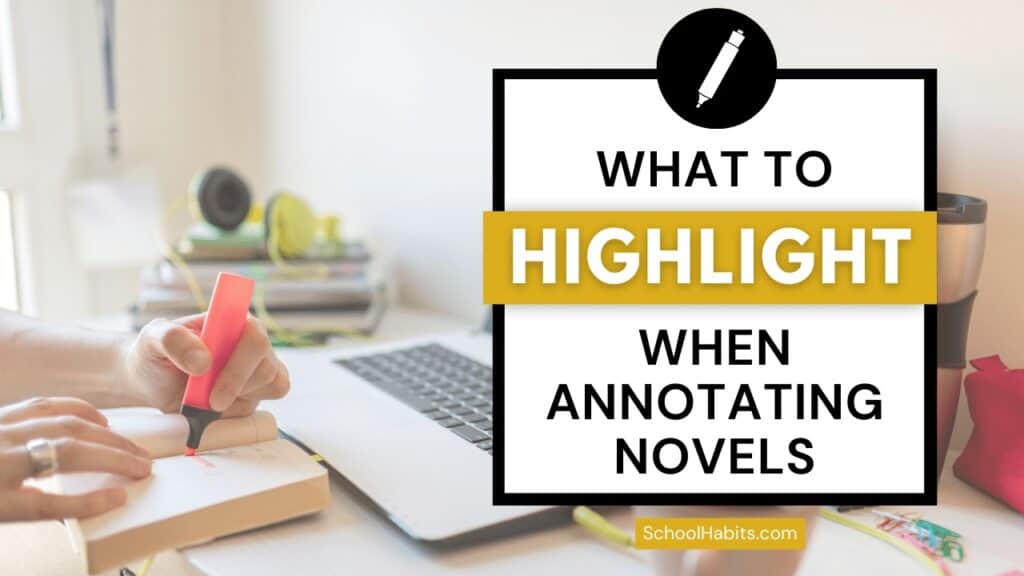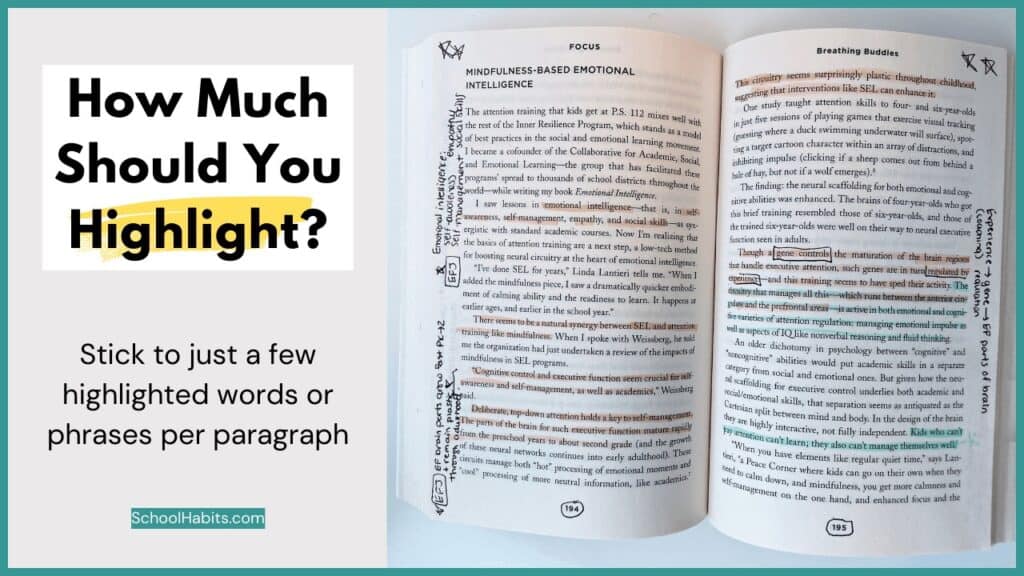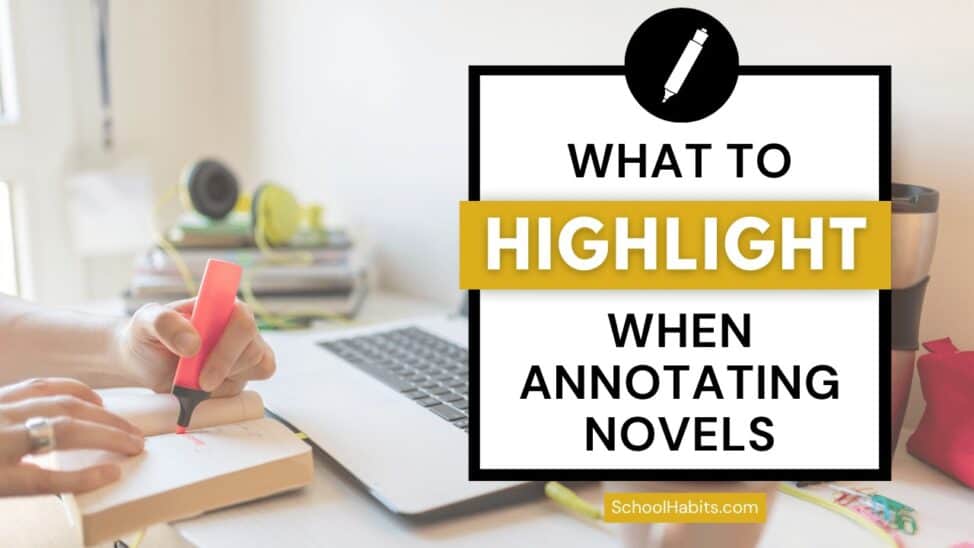
By Katie Azevedo, M.Ed.
There seems to be endless confusion around annotation techniques. “What do I highlight?” is one of the most common skill-based questions I’m asked, and so this blog post teaches you what to highlight when annotating novels.
In a future blog post, I’ll cover what to highlight when annotating other types of text.
Getting started: Highlighting isn’t annotating
Highlighting is only half of a good annotation strategy. Unless you’re only highlighting for one specific thing (explained below), you should always pair highlights with short notes about why you highlighted what you did. I explain exactly how to use this Highlight and Rewrite Strategy in this post and in this video.
When we fill our books and novels with highlights but no notes, we’re making the classic mistake of acting like we’ll remember why we highlighted what we did. No. We. Won’t. If we come back to the book even just one day later, our highlights won’t mean much to us at all. What a waste! (Also a waste? These common annotation mistakes you’re also probably making.)
So what’s the solution? As I said, always pair your highlights with a brief note that explains why you highlighted what you did. The image below provides an example.

How much should I highlight when annotating?
The obnoxious answer? Not too much, and not too little. I know, I know. You’re looking for an exact amount of words or sentences, but that’s not how it works. The right amount of highlights depends on several key factors, including:
- The complexity of the text (here are my best tips for reading hard books)
- What type of text you’re reading
- Why you’re reading the text
- What you want to get out of the text
With that said, a general rule of thumb is to have no more than a few highlights (and notes!) for each paragraph of text. If you’re reading a really challenging book, use these essential strategies, and consider highlighting and annotating a little more than you’d like to. The image above shows approximately how much to highlight in each paragraph; but again, it really depends on various factors.
What to highlight when annotating novels
Annotating novels is different than annotating other types of text, such as textbooks and academic articles. Use the list below, but please note that if you’re reading a book for pleasure, there’s no reason to annotate unless you really, really want to.
1. Specific evidence you are looking for
I can’t state this enough, but your annotations and highlights should have a purpose. Highlighting without a specific purpose is pointless. If your professor wants you to annotate for all figurative language, then highlight all instances of figurative language. If you’ll be writing an essay about a novel you’re reading, then highlight all quotes and evidence that support your thesis. Before you begin reading any novel, you should know what your purpose is; this purpose will guide your annotations.
2. References to themes
All novels have themes. If you don’t know the theme(s) of the book you’re reading, Google “what are the themes in [book you’re reading].” Then highlight and annotate all references to those themes.
3. Characterization
Characterization refers to words, scenes and descriptions that give the reader a deeper understanding of a character. If this is something you care about, or if you’ll be tested on/writing an essay about a character, consider highlighting and annotating these details.
4. Plot development
Almost all novels follow the classic 6-step story plot structure: exposition, conflict, rising action, climax, falling action and resolution. If you want to, or if you’re asked to, highlight evidence in your novel of each of the six stages (of course, paired with notes).
5. Foreshadowing and symbols
Foreshadowing is when the author drops clues about future events in the story. You can highlight these hints as they arise. Just a word of advice: Sometimes what we think are foreshadowing clues end up not being anything at all … and that’s okay!
7. Turning points / main events
Did something significant happen in the novel? Highlight and annotate it. Do you personally think something is a big deal but you’re not sure if others will think it’s a big deal? Highlight and annotate it because they’re your annotations.
8. Interesting parts
If you read something and it’s interesting to you, you should highlight and annotate it. Even if it’s a sentence that has nothing to do with what your teacher asks you to annotate, feel free to highlight it. The more you can connect with a text and recognize when something strikes you as attention-worthy, the more you’ll extract from the text overall. This, my friend, is the key to reading comprehension.
9. Parts you have questions about
Highlight parts of novels you’re confused about, or that you have questions about. In the margins next to your highlight, write a question mark or write down your actual question. You can get clarification on these parts from your teacher (in class the next day) or by Googling it.
10. Words that are deliberate and have significance
Good authors choose their words very carefully. Stated another way, sometimes an author will use particular words in particular instances in order to deliver a deeper meaning. Pay attention to these parts, highlight them, and annotate them with what you think they mean.
Let’s look at an example:
In the novel The Picture of Dorian Gray, Oscar Wilde writes “The curves of your lips rewrite history.” I would highlight the word “curves” because I think it has a double meaning. I think Wilde is literally referring the the curve of the character’s actual lips, but he could also have chosen the word to suggest that history could be cyclical (curved like a circle), or perhaps that history could be altered (curve or veer from its intended destination), or that perhaps the words out of Dorian’s mouth are lies (curved, unlike the truth). In this case, the word curve is interesting and worthy of a highlight.
11. Your own thoughts and reactions to sections of text
If your teacher offers no instructions about what to highlight when annotating novels, I suggest you start by highlighting and annotating your OWN thoughts and reactions to what you’re reading. If you read a passage that’s inspiring, highlight the inspiring parts and write a note about what struck you. If you read a part that’s surprising, highlight it and write why you’re surprised in the margins. Listen to your own inner dialogue when reading a novel. What are you thinking and feeling when reading certain parts of the text? Highlight those sections and write down your thoughts. Those, my friend, are truly the best annotations.
When it’s okay to use highlights only (and no notes)
As I explained at the beginning of this post, you should always pair highlights with annotations (notes in the margins), as highlights are useless without an explanation. With that said, there’s one exception to this rule.
It is okay to use just highlights with no margin notes if you are annotating a novel for just one purpose. For example, if you’re annotating a novel for evidence of one particular theme, it’s okay to simply highlight all instances of that theme. However, the moment you begin annotating for any additional purpose, you need to add notes to your highlights. For example, if you’re annotating a novel for two themes, you’d highlight all the relevant parts and write the theme connection in the margins.

